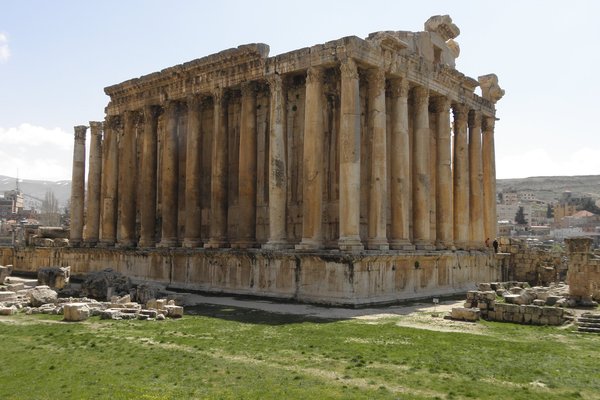Lebanon
Baalbek
Baalbek comprises the well-preserved remains of a Roman sanctuary.
With its colossal monuments and detailed stonework, it is considered one of the finest examples of Imperial Roman architecture. At the sanctuary, called Heliopolis at the time, Phoenician beliefs and the Greco-Roman pantheon were brought together. The site attracted many pilgrims.
Community Perspective: the most stunning WHS of Lebanon, very impressive for the height and solidity of the remains and its fine setting below the snow-capped mountains.
Site Info
Official Information
- Full Name
- Baalbek (ID: 294)
- Country
- Lebanon
- Status
-
Inscribed 1984
Site history
History of Baalbek
- 1984: Inscribed
- Inscribed
- Type
- Cultural
- Criteria
- i
- iv
Links
- UNESCO
- whc.unesco.org
- Official
-
- visit-lebanon.org — Visit Lebanon
- Related
-
- livius.org — Baalbek - by Livius, Articles on Ancient History
All Links
UNESCO.org
- whc.unesco.org — whc.unesco.org/
Official Website
- visit-lebanon.org — Visit Lebanon
Related Resources
- livius.org — Baalbek - by Livius, Articles on Ancient History
Community Information
- Community Category
- Archaeological site: Ancient Rome
Travel Information
Red Zone Travel Advisory
Lebanon hotspot
Recent Connections
-
No Map
-
Perfect Inscriptions
1984 -
Red Zone Travel Advisory
Lebanon South and East
Connections of Baalbek
- Individual People
-
-
Timur
-
Gertrude Bell
Photo taken June 1900 -
Johann Ludwig Burckhardt
Sept 28th - Oct 1 1810 -
Theodor Wiegand
"He also finished the excavations at Baalbek in Lebanon and published the results." (Wiki) "Baalbek : Ergebnisse der Ausgrabungen und Untersuchungen in den Jahren" 1898 bis 1905, (as editor) -
Ibn Battuta
"After Jabal Lubnan we came to the city of Ba'labakk [Baalbek], a beautiful and ancient place and one of the most agreeable cities in Syria, surrounded by glorious orchards and superb gardens, with flowing streams traversing its land, and rivalling Damascus in its boundless amenities." -
James Bruce
Bruce travelled through Syria, visiting Palmyra and Baalbek. (wiki) -
Erich von Däniken
Features in Chariots of the Gods
-
- Trivia
-
-
In the Pergamon museum
Jupiter sanctuary -
Out-of-place artifacts
Almost impossible to move with Bronze Age technology.See en.wikipedia.org
-
Google Doodles
22 November 2012, Lebanon National Day 2012See www.google.com
-
- History
-
-
Silk Roads
(Near) Classic Land Route; in ICOMOS thematic study but no details on role or function -
Ancient Roman colonies
-
Bronze Age
Excavations near the Jupiter temple have revealed the existence of ancient human habitation dating to the Early Bronze Age (2900-2300 BC) -
Thomas Cook Round the World tour 1872-1873
Mar 1873
-
- World Heritage Process
- Religion and Belief
-
-
Goddesses
Temple of VenusSee en.wikipedia.org
-
- Human Activity
-
-
Historical Graffiti
Temple of Bacchus at Baalbek, tourists and local visitors — left in both Arabic and Latin script -
Festivals
Baalbeck International FestivalSee en.wikipedia.org
-
- Constructions
-
-
Monumental Monoliths
The Trilothon - 3 stone blocks beneath the Temple of Jupiter - "Each one is 70 feet long, 14 feet high, 10 feet thick, and weigh around 800 tons". In the nearby quarry is a further stone known as the 'Stone of the South' (Hajar el Gouble) or 'The Stone of the Pregnant Woman' (Hajar el Hibla) which is estimated to weigh 1200 tonnes but was never completely separated from the surrounding rock and remains unfinished. (This stone is mentioned in the ICOMOS review map)
-
- Timeline
-
-
Built in the 1st century
Settlement at the site goes back to pre-history and, at the time of Alexander the Great, it was already a pilgrimage site. The city reached its apogee after the arrival of the Romans in 64BC and the great period of construction commenced with the decision of Augstus in 27 BC to build the Temple of Jupiter on earlier foundations. This was completed in the time of Nero c 60AD and was followed by the other Roman temples through to 3rd century AD (E.g Temple of Bacchus c 120 AD)
-
- WHS Hotspots
-
-
Lebanon hotspot
Lebanon Hotspot
-
- Visiting conditions
-
-
Foreigner prices
12,000 Lebanese pounds for foreigners, 7000 for LebaneseSee www.mot.gov.lb
-
Red Zone Travel Advisory
Lebanon South and East
-
News
No news.
Recent Visitors
Visitors of Baalbek
- Afshin Iranpour
- Alexander Barabanov
- Alexander Lehmann
- Ali Zingstra
- A. Mehmet Haksever
- Ammon Watkins
- Artur Anuszewski
- Ask Gudmundsen
- Aspasia
- Atila Ege
- AYB
- bergecn
- Bill Maurmann
- Bin
- Boj
- Bram de Bruin
- Chantal den Haan
- Christian Wagner
- Christravelblog
- Cirene Moraes
- Delphine Delaunay
- Dimitar Krastev
- Els Slots
- Eric Lurio
- Erik Jelinek
- Errol Neo
- Eva Kisgyorgy
- Fan Yibo
- futtaimhb
- Gabor
- George Gdanski
- giloudepuertorico
- Hadrianus
- Hammeel
- Harry Mitsidis
- henryjiao18
- Iain Jackson
- Ivan Rucek
- Janos
- Jarek Pokrzywnicki
- Jeffrey Chai
- João Aender
- Jonas Hagung
- Joyce van Soest
- Juha Sjoeblom
- Ken DJ
- KentishTownRocks
- Knut
- Krijn
- Lado Joel
- Little Lauren Travels
- Loic Pedras
- Luis Filipe Gaspar
- Lukasz Palczewski
- Maciej Gil
- Malgorzata Kopczynska
- marcel staron
- Marcobrey
- Martina Rúčková
- Michael Novins
- michaelsballard
- Mikan22
- Mikko
- Milan Jirasek
- Miloš Tašković
- MMM
- MoPython
- Morodhi
- Naim Y
- Niall Sclater
- Nihal Ege
- opperpco3
- palka25
- Peltzi
- Persian Globetrotter
- PeterH
- Philipp Leu
- Philipp Peterer
- Pieter Dijkshoorn
- Piotr Wasil
- Randi Thomsen
- Remski
- Rodinia
- Roger Ourset
- Roman Bruehwiler
- Sergio Arjona
- Solivagant
- Stanislaw Warwas
- Svein Elias
- Szabolcs Mosonyi
- Szucs Tamas
- Tarquinio_Superbo
- Thomas Buechler
- Thomas van der Walt
- Timothy C Easton
- tony0001
- triath
- Truls Brekke
- Vernon Prieto
- Walter
- Westwards
- Yongcheng Liu
- Zach
- Zoë Sheng
Community Reviews
Show full reviews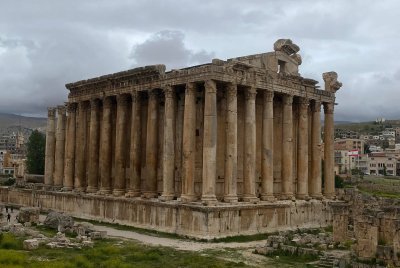
Visited in May 2023.
The WHO is located in the territory controlled by Hezbollah, so you need to be careful when planning your trip, there may be bombings in the surrounding area.I got here by bus from Beirut, not without adventures, I had to pay extra and change to another bus, but you can do without a taxi.Mysterious in its monumentality, the temple complex was built on the easternmost edge of the Roman Empire. A grandiose sacred complex was built here in the first century AD, which is considered to be one of the largest in the ancient world. The temple-sanctuary of Jupiter on a massive stylobate, the temple of Bacchus, the temple of Venus, there was also a temple of Mercury on the neighboring hill, but it did not survive.At the same time, it is not very clear who built it, for whom, why exactly in this place. Even dating is done by indirect signs. Meanwhile, it is obvious that a pilgrimage center of such a scale had to have an imperial significance. Perhaps a role was played by ancient traditions of religious worship in Heliopolis, as Baalbek was called under the Romans.In the nearby quarry, a giant thousand-ton block is still preserved, which was never completely processed, and in 2014 it was further excavated by archaeologists.The temple inspires respect, first of all, for its scale and a fairly good degree of preservation.
Keep reading 0 comments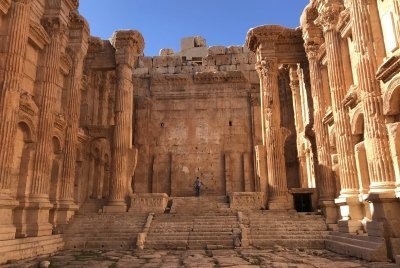
Save it for the last if you can, because not only is Baalbek the most stunning WHS of Lebanon, but even after couple of hundred sites visited, many many Roman ruins included, it still blew our minds and exceeded all our expectations. Just wow.
Baalbek site, located inside Baalbek, the administrative centre of the Bekaa valley and one of the places you wlll be advised against travelling to in Lebanon, contains spectacular ruins of Roman temples of Bacchus, temple of Jupiter and temple of Venus. They were built on a magnificent scale, 23 metres high, with columns 2.2 metres in diameter. The sheer scale of everything is mind-blowing. I enjoyed climbing on top of one of the large Corinthian-style column head. Another awesome thing, you can walk around, climb wherever you want, without some nasty local guard whistling at you to shoo away (greetings to Delphi). There are two museums on-site: one in the medieval tower and another in an underground tunnel on your way back. There's also a small tourist info centre by the ticket office, though at the time of our visit it was blessingly vacant with some booklets of other sights, in Arabic only.
We got there with a car, passed some checkpoints on the way, but nobody checked our passports, the soldiers just waved us away with attests to the calm situation in the area. No Hezbollah check points I've read about in other blogs. But you will feel it's a Hezbollah territory, especially …
Keep reading 0 comments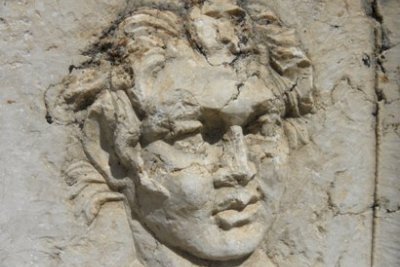
I went on an organized day tour from Beirut to Baalbek - one that efficiently also encompasses the WHS of Anjar (and some wine tasting at Ksara, but I am not fond of that). We were a group of six, of which I was the only one having come to Lebanon as a tourist. The others were here for work or study.
Baalbek lies quite deep into the Bekaa Valley, which means that we first had to cross Mount Lebanon. It had been snowing until last week, and snow was still visible beside the road at the mountain pass. The road is not in great shape and is as busy with traffic as everywhere I have seen so far in Lebanon. The Bekaa is a fertile valley and the main agricultural zone of Lebanon. There were lots of fruit and vegetable stalls next to the road, as well as hanging slaughtered animals. Remarkable I also found the numerous tents of Syrian Bedouins, who apparently come here to work as agricultural labourers. The current city of Baalbek mostly has a Shi'ite population, and they quite recently built a glittering new mosque not far from the archeological site. In town, there also is a large Palestinian refugee camp.
We started the tour with a quick visit to a quarry for the Baalbek site, at which it becomes clear how big the monoliths were that were used for construction. The Baalbek complex begins with the Temple of Venus, just outside the …
Keep reading 0 comments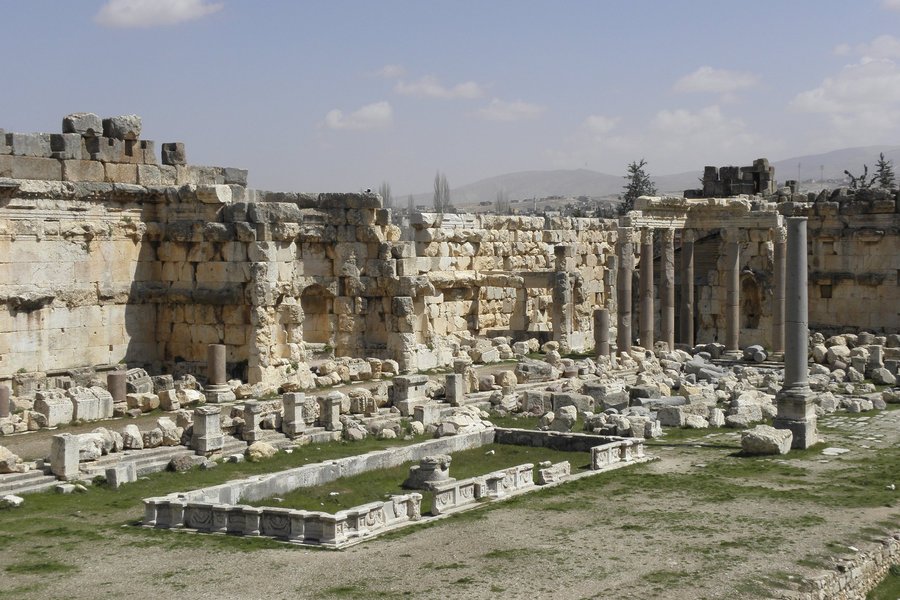
July 2003,a stage and seats were being set up for a play during my visit so some of the site was unaccessable,but the two main temples of Jupiter and Bacchus were magnificent to see as as grande in size to behold,its almost unimaginable the size of the Jupiter Temple during its heyday as is evident buy the 6 remaining 67 foot high columns that still stand,when walking around the Temple of Bacchus makesure to look up under the outside columns and notice the intricatly carved rooftop colonaide as i said i was there in july blazing hot but maby 10 people there the whole time during my visit,a must see
Keep reading 0 comments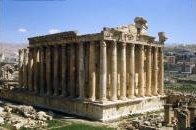
Baalbek is the great “must do” site if you are in Lebanon. It is situated not far off the road across the mountains to Damascus and could conveniently be taken in on such a journey.
This detour takes you into the “infamous” Bekaa Valley. We were there in 1999 and, apart from passing under archways carrying pictures of Ayatollah Khomeini, we saw nothing else to remind us that this is the heartland of Hezbollah in Lebanon. Everything was very relaxed.
The ruined city is primarily Roman but had Phoenician and Greek origins. The height and solidity of the remains is very impressive. The setting below the snow-capped mountains is also rather fine. We were there in April and, although we had a rentacar, the road west over the mountains to the Cedars of Lebanon WHS was still closed by snow but should be an interesting journey a month or so later. A couple of hours to wander round should be enough for all but “Roman Architecture buffs”.
Keep reading 0 comments
